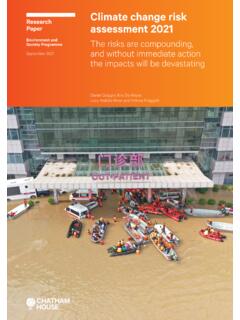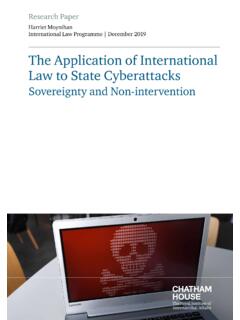Transcription of Artificial Intelligence and the Future of Warfare
1 Research Paper M. L. Cummings International Security Department and US and the Americas Programme January 2017. Artificial Intelligence and the Future of Warfare Artificial Intelligence and the Future of Warfare Summary Both military and commercial robots will in the Future incorporate Artificial Intelligence ' (AI). that could make them capable of undertaking tasks and missions on their own. In the military context, this gives rise to a debate as to whether such robots should be allowed to execute such missions, especially if there is a possibility that any human life could be at stake. To better understand the issues at stake, this paper presents a framework explaining the current state of the art for AI, the strengths and weaknesses of the technology, and what the Future likely holds.
2 The framework demonstrates that while computers and AI can be superior to humans in some skill- and rule-based tasks, under situations that require judgment and knowledge, in the presence of significant uncertainty, humans are superior to computers. In the complex discussion of if and how the development of autonomous weapons should be controlled, the rapidly expanding commercial market for both air and ground autonomous systems must be given full consideration. Banning an autonomous technology for military use may not be practical given that derivative or superior technologies could well be available in the commercial sector. A metaphorical arms race is in progress in the commercial sphere of autonomous systems development, and this shift in R&D effort and expenditure from military to commercial settings is problematic.
3 Military autonomous systems development has been slow and incremental at best, and pales in comparison with the advances made in commercial autonomous systems such as drones, and especially in driverless cars. In a hotly competitive market for highly skilled roboticists and related engineers across the sectors most interested in AI, aerospace and defence, where funding is far outmatched by that of the commercial automotive or information and communication sectors, is less appealing to the most able personnel. As a result, the global defence industry is falling behind its commercial counterparts in terms of technology innovation, with the gap only widening as the best and brightest engineers move to the commercial sphere. As regards the Future of Warfare as it is linked to AI, the present large disparity in commercial versus military R&D spending on autonomous systems development could have a cascading effect on the types and quality of autonomy that are eventually incorporated into military systems.
4 One critical issue in this regard is whether defence companies will have the capacity to develop and test safe and controllable autonomous systems, especially those that fire weapons. Fielding nascent technologies without comprehensive testing could put both military personnel and civilians at undue risk. However, the rapid development of commercial autonomous systems could normalize the acceptance of autonomous systems for the military and the public, and this could encourage state militaries to fund the development of such systems at a level that better matches investment in manned systems. 1 | Chatham House Artificial Intelligence and the Future of Warfare Introduction This is a draft of the author's contribution to a forthcoming Chatham House report on Artificial Intelligence , to be published in the autumn of 2017.
5 The rise in the use of unmanned aerial vehicles (UAVs) commonly known as drones in both military and commercial settings has been accompanied by a heated debate as to whether there should be an outright ban on what some label killer robots' ( Future of Life Institute, 2015;. Human Rights Watch, 2013; Human Rights Watch and International Human Rights Clinic, 2016). Such robots, which could be in the air, on the ground, or in and under water, theoretically incorporate Artificial Intelligence ' (AI) that would make them capable of executing missions on their own. The debate, which has many dimensions and stakeholders, concerns whether artificially intelligent machines should be allowed to execute such military missions, especially if there is a possibility that any human life could be at stake.
6 Given the complexity of the matter, a working definition of AI is needed. There is no one commonly agreed definition, even among computer scientists and engineers, but a general definition of AI is the capability of a computer system to perform tasks that normally require human Intelligence , such as visual perception, speech recognition and decision-making. This definition is, however, inherently oversimplified, since what constitutes intelligent behaviour is also open to debate. Arguably, by this definition a house thermostat is intelligent because it can perceive and adjust the temperature. This is substantially different from AI whereby a UAV selects and engages targets without meaningful human control, which is the common assumption for autonomous weapons.
7 Another critical factor to consider in the debate over autonomous weapons is the increasing inability to disambiguate commercial drone autonomy from that of military UAVs. Indeed, with the rapidly expanding commercial market for both air and ground autonomous systems, there is evidence of some shifting in AI expertise from military to commercial enterprises. As a result, banning an autonomous technology for military use may not be practical given that derivative or superior technologies could well be available in the commercial sector. In addition, the asymmetrical development of the commercial autonomous system market would be likely to result in a lack of expertise for governments and militaries, which could lead to compromised and unsafe autonomous systems, both fully and semi-autonomous.
8 This paper presents first a framework explaining the current state of the art for AI, the strengths and weaknesses of AI, and what the Future likely holds. Given that the advancement of AI is inextricably linked to the expertise of the engineers developing these systems, the case is then made that the shift in expertise from the military to the commercial sector will further complicate policy discussions on autonomous weapon, and will make it difficult for governments to deploy and manage these systems. 2 | Chatham House Artificial Intelligence and the Future of Warfare How robots think To better understand the nuances of AI, it is important first to understand the difference between an automated and an autonomous system. An automated system is one in which a computer reasons by a clear if then else, rule-based structure, and does so deterministically, meaning that for each input the system output will always be the same (except if something fails).
9 An autonomous system is one that reasons probabilistically given a set of inputs, meaning that it makes guesses about best possible courses of action given sensor data input. Unlike automated systems, when given the same input autonomous systems will not necessarily produce the exact same behaviour every time; rather, such systems will produce a range of behaviours. Human Intelligence generally follows a sequence known as the perception cognition action information processing loop, in that individuals perceive something in the world around them, think about what to do, and then, once they have weighed up the options, make a decision to act. AI. is programmed to do something similar, in that a computer senses the world around it, and then processes the incoming information through optimization and verification algorithms, with a choice of action made in a fashion similar to that of humans.
10 Figure 1 illustrates how an autonomous system embedded with AI thinks' and makes decisions in this way. Figure 1: How AI of an autonomous system works Source: Adapted from Hutchins, Cummings, Draper and Hughes (2015). 3 | Chatham House Artificial Intelligence and the Future of Warfare While there are many parallels between human Intelligence and AI, there are stark differences too. Every autonomous system that interacts in a dynamic environment must construct a world model and continually update that model (as shown in Figure 1). This means that the world must be perceived (or sensed through cameras, microphones and/or tactile sensors) and then reconstructed in such a way that the computer brain' has an effective and updated model of the world it is in before it can make decisions.












